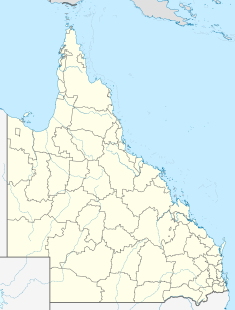Langshaw Marble Lime Works
| Langshaw Marble Lime Works | |
|---|---|

Remains of the Langshaw Marble Lime Works, 2003
|
|
| Location | 12 Julius Street, New Farm, City of Brisbane, Queensland, Australia |
| Coordinates | 27°28′06″S 153°02′26″E / 27.4684°S 153.0405°ECoordinates: 27°28′06″S 153°02′26″E / 27.4684°S 153.0405°E |
| Design period | 1870s - 1890s (late 19th century) |
| Built | c. 1878 - c. 1881 |
| Official name: Remains of the Langshaw Marble Lime Works, Langshaw Marble Lime Works | |
| Type | state heritage (built, archaeological) |
| Designated | 13 October 1997 |
| Reference no. | 601885 |
| Significant period | 1878-c. 1881 (fabric) c. 1881-1894 (historical) |
| Significant components | kiln |
Langshaw Marble Lime Works is a heritage-listed remains of a former lime kiln at 12 Julius Street, New Farm, City of Brisbane, Queensland, Australia. It was built from c. 1878 to c. 1881. It was added to the Queensland Heritage Register on 13 October 1997.
The lime kilns on the banks of the Brisbane River at New Farm, below Julius Street, appear to have been established in the late 1870s by Brisbane merchant James Campbell, who traded as James Campbell and Sons from 1882 and James Campbell and Sons Ltd from 1896, and who had established the Langshaw Marble Lime Works on the New Farm site by 1881.
The firm of James Campbell and Sons was one of Brisbane's earliest and longest established suppliers of building materials, which in the second half of the 19th century specialised in the retailing of lime, cement, plaster, paints and timber, and operated saw and planing mills, plantations, lime works and pottery kilns in a number of locations in southeast Queensland, as well as Campbell's wharf and warehouse at Creek Street, Brisbane, and a substantial fleet of freight vessels.
James Campbell was born in 1830 in Perthshire, Scotland, and in his youth was apprenticed as a plasterer. He married Isabella Mitchell in February 1853 shortly before emigrating to Moreton Bay, where they arrived in June that year. Finding little employment in Brisbane for a plasterer, James opened a small store in George Street, retailing building materials obtained from Sydney. Moreton Bay was passing through a recession at this period, and Campbell's first venture failed. He took odd jobs - timbergetting, fencing, carpentering, painting, bricklaying - until in 1854 he was able to acquire land in Creek Street, at the corner of Charlotte Street, where he erected a single-storeyed building and commenced business as City Lime, Cement and Plaster Stores - the business which ultimately became James Campbell and Sons. Campbell's business prospered steadily through the 1850s and 1860s. In 1857 he bought additional land in Charlotte Street and in 1864 purchased 36 perches in Creek Street, opposite the city wharves, where he erected a 2-storeyed timber store and residence which remained the firm's headquarters until replaced in 1909 by an imposing five-storeyed brick warehouse. From the early 1860s, Campbell is understood to have operated lime kilns at Breakfast Creek and Lytton, supplied with shell and coral collected from Moreton Bay by sub-contractors.
...
Wikipedia


